Lithium Market Trends and Strategic Insights
A sustainable opportunity for the oil and gas industry - are you ready to turn waste into value?

Executive Summary
The lithium race is on - and the oil and gas industry is sitting on untapped potential.
Global lithium demand is expected to grow 3.5x by 2030, driven by the rapid rise of electric vehicles and renewable energy storage. But traditional mining can't keep up. It's slow, expensive, and environmentally damaging, creating bottlenecks and intensifying the global push for secure, local, and sustainable supply.
This is where opportunity meets innovation.
Lithium Harvest turns produced water - a costly byproduct of oil and gas operations - into high-value, battery-grade lithium. Our patented process is faster to deploy, more sustainable, and far more cost-effective than conventional extraction methods.
It's not just a new way to extract lithium - it's a path to profit. Oil and gas companies now have a unique chance to diversify operations, boost ESG performance, and gain a first-mover edge in one of the world's fastest-growing markets.
Table of contents:
- Introduction to the Lithium Market
- The Booming Lithium Market
- The World Needs More Sustainable Lithium - Are You Ready to Lead?
- Geographical Distribution and Sources
- Key Market Drivers of the Lithium Industry
- Governments and Regulations
- Technological Benchmark
- Introduction to Lithium Harvest
- Lithium Harvest's Competitive Advantage
- Strategic Fit and Market Opportunity for Oil and Midstream Companies
- Partner with Lithium Harvest for Sustainable Lithium Extraction
Introduction to the Lithium Market
The global lithium market is exploding - and it’s only just getting started.
Electric vehicles and renewable energy storage are fueling a massive surge in demand. By 2030, the world will need more than 3.5 times the lithium it used in 2023. But there’s a problem: traditional mining can’t keep up. It’s too slow, too expensive, and far too damaging to the environment.
That’s why the market isn’t just calling for more lithium - it’s demanding a better way to get it.
Sustainability isn’t a nice-to-have anymore - it’s a deal-breaker. Investors, regulators, and buyers are putting pressure on the industry to clean up its act. Lithium extraction with lower emissions, lower water use, and a smaller footprint is no longer a niche. It’s the future.
For oil and gas companies, this presents a rare opportunity.
By partnering with Lithium Harvest, you can turn an environmentally costly challenge - produced water - into a new revenue stream. Our patented solution transforms oilfield wastewater into high-purity lithium using a fast, sustainable, and cost-effective process. You can diversify your business, boost ESG performance, and tap into a booming market - without changing your core operations.
The lithium market is shifting fast. And the companies that move first will win big. Let’s show you how.
The Booming Lithium Market
Global Demand Is Soaring
You already know the world is racing toward electrification, but the speed is staggering.
Lithium is at the center of this shift. It powers EV batteries, backs up renewable energy grids, and supports the entire clean energy infrastructure. From 2023 to 2030, global lithium demand is expected to grow 3.5x - and that’s a conservative estimate. Governments, automakers, and energy providers are all driving this surge as they push to meet climate targets and decarbonize operations.
For companies like yours, this is more than a market trend - it’s a once-in-a-generation opportunity to tap into a booming sector by turning existing resources into high-value lithium.
The Supply Struggle
The problem? Supply can’t keep up.
Traditional lithium extraction is slow, expensive, and harmful to the environment. Hard rock mining and evaporation ponds take years to permit and build, and use massive amounts of water and land. Worse, most of the global supply is concentrated in just a handful of countries, creating serious risks for downstream buyers.
By 2029 - or sooner - demand is expected to outpace supply, threatening to stall the green energy transition.
That’s where your operations come in.
You can help close the supply gap using something you already have: produced water. Our patented process extracts lithium from this overlooked resource, delivering a faster, cleaner, and more cost-effective way to enter the market while aligning with sustainability goals.
It’s a strategic way to grow - and lead - in the new energy economy.
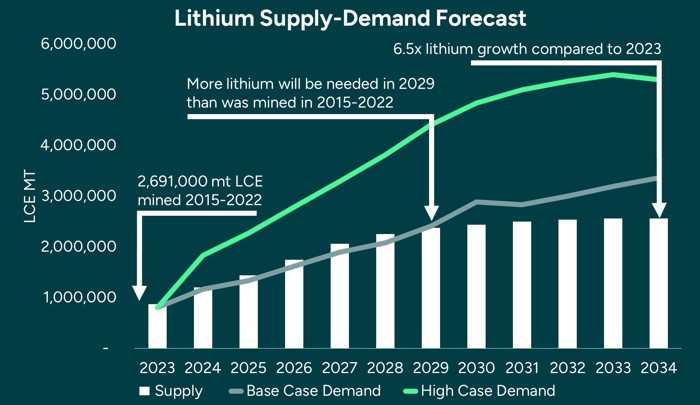
The World Needs More Sustainable Lithium – Are You Ready to Lead?
The race is on – and sustainable lithium is the prize.
Global demand for lithium is exploding, driven by electric vehicles, energy storage, and the green transition. But traditional mining can't keep up - and worse, it’s under fire for water depletion, high emissions, and land disruption. As regulations tighten and customers demand cleaner materials, the pressure is mounting.
Here’s the opportunity: Oil and gas companies are sitting on a hidden lithium supply - produced water. What’s long been treated as waste can now be a valuable source of battery-grade lithium. And Lithium Harvest is making it possible.
Why This Matters Now
Sustainable lithium isn’t just a nice-to-have - it’s a market requirement.
EV makers, battery producers, and energy giants are prioritizing ESG-compliant materials. That means responsibly sourced lithium is becoming a competitive edge - and a requirement in supplier contracts.
By extracting lithium from produced water, you not only meet this demand but also turn a waste stream into a profit center. And you do it without the footprint, timeline, or backlash of conventional mining.
A Strategic Advantage for Oil and Gas
This isn’t just good for the planet - it’s smart business.
- Lithium demand is expected to grow 3.5x by 2030.
- A supply shortage of up to 10 million tons of LCE is projected by 2034 in high-demand scenarios.
- Produced water is already on-site - you just need the right solution to extract value from it.
With Lithium Harvest’s technology, you can generate new revenue, boost ESG scores, and strengthen your role in the energy future - all while maintaining your core operations.
Let’s Lead the Transition – Together
This is your moment to surge ahead. As the world scrambles to secure lithium, those who move first will shape the market.
Partner with Lithium Harvest to turn your produced water into a valuable asset - and secure your company’s place at the forefront of sustainable energy.
Let’s talk about how we can help you lead the next era of energy.
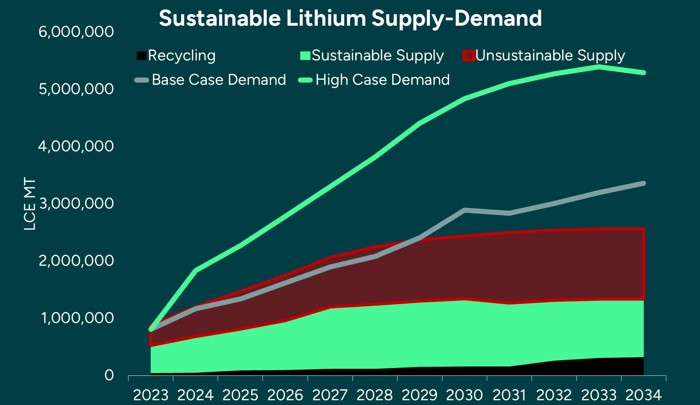
Your industry is sitting on an untapped revenue opportunity. With Lithium Harvest’s solution, you can meet surging lithium demand sustainably and turn that opportunity into profit.
Geographical Distribution and Sources
Lithium's Global Bottleneck - and the U.S. Opportunity
90% of the world’s lithium production is concentrated in just four countries. Australia, Chile, China, and Argentina dominate supply, with China refining a massive share of the world’s battery-grade lithium.
That means most of the lithium powering EVs, energy storage systems, and grid resilience is processed far from where it's needed, creating critical vulnerabilities in the global supply chain. For the U.S. and other countries, this is a major energy security risk.
The U.S. Is Falling Behind - But Oil & Gas Can Change That
Today, the U.S. accounts for less than 1% of global lithium production. Despite vast untapped potential, most domestic lithium remains in the ground or overlooked sources like oilfield wastewater.
At the same time, demand is surging and policy is shifting. The Inflation Reduction Act and other federal initiatives have made domestic mineral production a strategic imperative, especially for lithium.
Here’s where it gets interesting:
66% of global lithium still comes from ore mining. Only 10% comes from Direct Lithium Extraction (DLE) – the part with the most room for growth.
Why This Is a Strategic Moment for U.S. Oil and Midstream Companies
Oil and gas companies already manage massive volumes of lithium-rich water. With the right partner, that water can be transformed into a domestic supply of battery-grade lithium, right at the source.
This means:
- Creating new revenue streams without new land use or drilling
- Supporting U.S. energy independence by reducing reliance on foreign lithium
- Aligning with policy priorities and stakeholder expectations around ESG and sustainability
You’re already producing the resource - now it’s time to extract the value. Partnering with Lithium Harvest puts you at the center of the U.S. lithium strategy while future-proofing your operations.
Let’s talk about how to turn your produced water into a strategic asset.
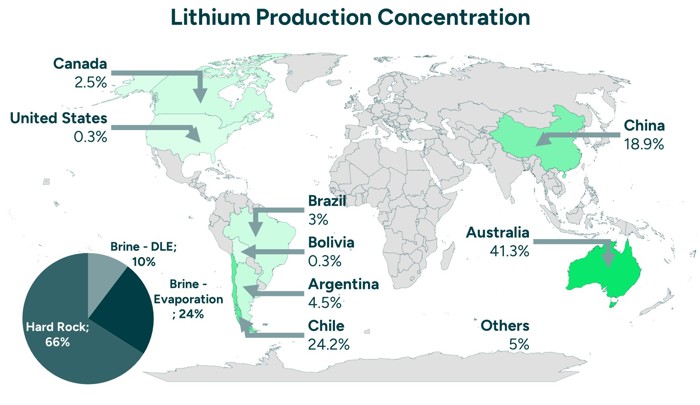
It's important to identify lithium resources in the U.S. so that our supply does not rely on single companies or countries in a way that makes us subject to economic or political manipulation.
Key Market Drivers of the Lithium Mining Industry
The lithium mining industry is booming, driven by several powerful trends that are reshaping global markets. As demand for clean energy solutions and electric vehicles (EVs) intensifies, lithium has become one of the most coveted resources. Here are the primary factors fueling its growth:
-
Surging Demand for Electric Vehicles (EVs)
Electric vehicles aren’t just the future - they’re already reshaping the present. EVs are the single most significant driver of lithium demand, accounting for 87% of global consumption.
Governments and automakers worldwide are racing to cut emissions and electrify transportation. Over 20 major car manufacturers - representing 90% of global vehicle sales in 2023 - have set ambitious electrification targets.
What does that mean for lithium?
- EV sales are booming - from 14 million units in 2023 to a projected 50 million by 2030.
- Lithium-ion batteries, the heart of every EV, depend on lithium for their high energy density and performance.
- As EV production scales, demand for reliable, sustainable lithium sources is skyrocketing.
This unstoppable trend puts lithium at the center of the clean mobility revolution - and opens the door for new suppliers to meet this surge.
-
Energy Storage Solutions and Renewable Energy Integration
As the world shifts to cleaner energy, lithium is becoming the backbone of grid reliability.
The rise of solar and wind is transforming power generation, but their intermittency demands fast, flexible storage solutions. That’s where lithium-ion batteries come in.
Why it matters:
- Grid-scale energy storage is booming, enabling utilities to store excess power and stabilize supply during peak demand.
- Lithium-ion batteries are the go-to solution – thanks to their scalability, energy density, and proven reliability.
- Governments are investing billions in energy storage to meet climate targets and modernize infrastructure.
For oil, gas, and midstream companies looking to diversify, this growing demand offers a high-impact entry point into the clean energy market by turning lithium-rich produced water into a valuable resource fueling the next generation of power systems.
Learn more about the perfect marriage between oil & gas and renewables.
-
Battery Boom, Lithium Bottleneck
Global battery capacity is growing fast, but can the lithium supply keep up?
Driven by the electrification of transport and energy systems, the world is racing to scale battery production:
- U.S. battery manufacturing is projected to grow nearly 9x by 2030
- The EU is tracking an 11.7x increase
- Worldwide capacity is expected to rise more than 5x
But there’s a catch: without major investments in lithium extraction and refining, only 36% of that capacity may be usable. The rest? Stranded potential.
This looming supply gap represents a high-value opportunity for oil and midstream companies. By converting produced water into lithium, you’re not only reducing waste but also helping power the global battery buildout while unlocking new revenue.
-
Battery Tech Is Evolving - And So Is Lithium Demand
Breakthroughs in battery innovation are reshaping what’s possible in electrification - and ramping up the pressure on lithium supply chains.
From solid-state batteries to high-efficiency NMC (nickel-manganese-cobalt) chemistries, next-gen battery technologies require more lithium per output unit than ever. Why?
- Higher energy density
- Longer battery lifespan
- Faster charging capabilities
These aren’t just technical upgrades - they’re business accelerators for automakers, grid providers, and industrial sectors. But every advancement depends on a reliable supply of high-purity lithium.
That’s where Lithium Harvest comes in. Our sustainable lithium compounds support the next generation of batteries - without the delays, costs, or footprint of traditional mining.
-
Policy Tailwinds Are Supercharging Lithium Demand
Global governments aren’t just supporting the energy transition but incentivizing it.
From the Inflation Reduction Act (IRA) in the U.S. to the European Critical Raw Materials Act, policymakers are offering billions in:
- Tax credits for EV purchases
- Incentives for lithium and battery production
- Subsidies for renewable energy and critical minerals infrastructure
At the same time, countries are phasing out internal combustion engines, pushing automakers to scale electric fleets faster than ever. The result? A dramatic increase in lithium demand and a race to secure a reliable, local supply.
This is a moment for oil and midstream companies to act - and transform a regulatory shift into a revenue opportunity. By partnering with Lithium Harvest, you can position your business at the heart of the government-backed energy transformation.
-
Global Supply Chain Shake-Up and the Race for Resource Security
The strategic importance of lithium has led to a reshuffling of global supply chains, with countries aiming to secure domestic sources of this critical mineral. Concerns over supply chain vulnerabilities, particularly the heavy reliance on China for lithium processing, have prompted nations like the United States and the European Union to explore ways to localize lithium production and reduce dependency on foreign suppliers. These efforts drive investments in new mining projects, lithium recycling, and processing facilities in regions like North America and Europe.
--
The world is rethinking where its lithium comes from - and who controls it.
Today’s overdependence on a handful of countries, especially China, for lithium processing has exposed critical vulnerabilities in the global supply chain. In response, governments across the U.S. and EU are aggressively reshoring supply chains to reduce risk, increase resilience, and secure strategic mineral independence.
This shift is fueling massive investments in:
- Domestic mining and processing facilities
- Lithium recycling technologies
- Strategic partnerships for localized production
This reshuffling opens a powerful opportunity for oil and midstream companies: use your existing infrastructure to supply lithium from produced water, right here, at home. It’s a way to tap into national policy priorities, support energy security, and unlock new revenue from your current operations.
-
Growth in Consumer Electronics
It’s not just EVs driving lithium demand - it’s everything in your pocket, bag, and on your wrist.
Lithium-ion batteries power nearly every modern device, from smartphones and laptops to tablets and wearables. As consumer electronics become more advanced, smaller, and power-hungry, the demand for high-performance, rechargeable batteries continues to rise.
Even as electric vehicles dominate the headlines, consumer tech remains a consistent and growing pillar of the lithium market. For producers, that means diversified demand and long-term opportunity.
-
Global Decarbonization and Sustainability Initiatives
The world is racing toward net-zero, and lithium is fueling that transition.
Lithium-ion batteries are at the heart of global decarbonization efforts, from EVs and clean energy grids to sustainable manufacturing. As governments commit to carbon neutrality and climate goals tighten, demand for responsibly sourced lithium is only accelerating.
For oil and gas companies, this is more than an environmental shift - it is a strategic entry point into the future of energy. Sustainable lithium is not just needed - it is non-negotiable.
Governments and Regulations
Policy is no longer a backdrop - it's a driving force.
Governments worldwide are reshaping the future of energy with bold regulations and aggressive incentives. From tax credits for EVs to billions in funding for domestic lithium production, the message is clear: clean energy is a national priority.
These regulatory tailwinds create a powerful opportunity for companies in oil, gas, and midstream. With the right partnerships and technology, you can align with policy shifts, access incentives, and secure a profitable role in the clean energy supply chain.
Regulations aren't a hurdle - they're your green light to act.
-
Global Alliances
Net-zero is no longer a vision - it’s a global mandate.
More than 70 countries - including the largest emitters like China, the U.S., and the EU - have pledged to reach net zero, covering over 76% of global emissions. Thousands of businesses, cities, and institutions are backing that pledge with action. Over 3,000 companies are setting emissions targets through the Science-Based Targets initiative. More than 1000 cities, over 1000 educational institutions, and 400 financial institutions have joined the Race to Zero, committing to halve emissions by 2030.
Why it matters: The energy sector accounts for nearly 75% of all greenhouse gas emissions. And decarbonizing it depends on one thing - replacing fossil fuels with renewables backed by large-scale storage and electrification.
That means more batteries. And that means more lithium.
The global alliance around net-zero is accelerating lithium demand and the need for sustainable, fast-to-market extraction methods. This is your opportunity to lead.
-
The End of the Road for Combustion Engines
The phaseout of internal combustion engine (ICE) vehicles is no longer hypothetical - it’s on the calendar.
Governments worldwide are setting deadlines to ban the sale of new gas - and diesel-powered vehicles. Countries across Europe, central U.S. states, and global cities are committing to phaseouts starting as early as 2030.
But it doesn’t stop at cars – fossil-fueled buses, trucks, and even ships are being targeted by new policies and regulations.
And industry isn’t waiting.
More than 100 nations, automakers, and financial institutions - including Ford, GM, and Volvo - have signed the Glasgow Declaration on Zero-Emission Cars and Vans. Their pledge is to end the sale of combustion vehicles in key markets by 2035 and globally by 2040.
The implication is clear: the future is electric, and the world will need massive amounts of sustainable lithium.
-
The Inflation Reduction Act
The Inflation Reduction Act (IRA) isn’t just policy - it’s fuel for a U.S. clean energy boom, and lithium is at the center of it.
Here’s what it means for the lithium market:
- EV tax credits are tied to U.S.-sourced materials: To qualify for the full $7,500 EV tax credit, batteries must meet strict sourcing rules, with a growing share of critical minerals like lithium extracted or processed in the U.S. or allied nations. This is driving urgent demand for domestic lithium.
Massive investment in domestic manufacturing:
- $3 billion for clean vehicle and component manufacturing through the Department of Energy
- $2 billion for Domestic Manufacturing Conversion Grants
- Advanced Manufacturing Production Credit to boost U.S. battery and critical mineral production
Since the IRA passed:
- $85 billion has poured into U.S. EV and battery manufacturing
- EV sales have tripled, according to the White House
Lithium Supply Needs to Catch Up - Fast
The U.S. battery manufacturing capacity is set to grow:
- From 119 GWh today
- To 440 GWh by 2025
- And over 1,000 GWh by 2030
That’s nearly a 9x increase, and lithium supply needs to scale
What it means for your business: With demand exploding and policy on your side, now is the time to secure domestic lithium sources and explore offtake opportunities. Partnering with Lithium Harvest puts you in a prime position to serve this surging market with sustainable, U.S.-sourced lithium compounds.
-
The European Critical Raw Material Act
The European Union is racing to secure the raw materials needed for its green transition, and lithium is at the top of the list.
In March 2023, the EU introduced the Critical Raw Materials Act (CRMA) - a bold regulatory framework to boost self-reliance and reduce overdependence on single-country suppliers.
The 2030 targets are clear:
- At least 10% of the EU’s annual raw material consumption must be sourced from domestic extraction.
- At least 40% must be processed within the EU.
- At least 15% must come from recycling.
- No more than 65% of any critical raw material can be sourced from a single non-EU country at any processing stage.
What it means for the lithium market: The EU knows it won’t be fully self-sufficient, but it’s focused on strategic partnerships, investment in global supply, and streamlined permitting for critical raw material projects across Europe.
That means faster project approvals, more support for breakthrough technologies, and increased funding for circularity, sustainability, and workforce development through new partnerships and initiatives like the Raw Materials Academy.
Why this matters for your business: With Europe committing to diversifying and strengthening its supply chains, sustainable lithium producers like Lithium Harvest are well-positioned to support EU supply needs, especially through partnerships that prioritize ESG and long-term resilience.
Now is the time to align your strategy with this shift.
-
The European Batteries Regulation
The European Union’s new Battery Regulation, effective as of 18 February 2024, marks a bold step toward cleaner, safer, and more circular battery production. While the regulation is now in force, its key provisions are being rolled out gradually to allow manufacturers time to comply and adjust operations.
Why it matters: This regulation sets strict environmental and sustainability benchmarks for any battery entering the EU market. Manufacturers and importers must comply with evolving standards or face market withdrawal or penalties under national enforcement.
Carbon Footprint Disclosure Becomes Mandatory
One of the most impactful components of the regulation is mandatory carbon footprint disclosure, required by 18 February 2025. This applies to the entire battery life cycle:
- Raw material extraction
- Processing and manufacturing
- Recycling and end-of-life handling
(Importantly, the battery’s use phase is excluded from this requirement.)
This rule is designed to increase transparency and reward companies that minimize the environmental footprint of their supply chains.
Supporting the Green Transition
Batteries are at the heart of the EU’s green transition - powering sustainable mobility and helping achieve climate neutrality by 2050.
To reinforce this goal, the regulation will introduce:
- Mandatory declarations
- Performance classes
- Carbon footprint thresholds
Starting in 2025, these will apply to electric vehicle (EV) batteries, rechargeable industrial batteries, and batteries used in light means of transport (like e-bikes and scooters).
What this means for your business: Complying with the EU Battery Regulation is not just about market access - it’s a strategic move. Customers, regulators, and partners will increasingly expect your batteries to meet higher environmental standards. By working with Lithium Harvest, you’re sourcing battery-grade lithium with a lower carbon footprint, helping you stay ahead of the curve.
Technological Benchmark
At Lithium Harvest, we deliver one of the most cost-efficient and sustainable lithium extraction processes available today, outpacing both traditional mining and competing solutions. Here’s how we lead the industry:
- Unmatched cost-efficiency: Traditional mining and evaporation ponds are capital-heavy, time-consuming, and resource-intensive. Our solution flips that model, turning oilfield wastewater into high-value lithium using existing infrastructure. That means lower CapEx, lower OpEx, and a faster return on investment.
- One of the most sustainable lithium solutions: We turn waste into one of the world’s most sustainable lithium sources. By using produced water from oil and gas operations, our process slashes water use and carbon emissions, eliminating the need for land-intensive, high-impact mining. It’s a sustainability win that aligns with the highest ESG standards.
- Fastest to market: While traditional projects can take years, our modular solution deploys in 12-15 months, allowing you to quickly tap into new revenue streams. Faster deployment means faster payback and an edge in an increasingly competitive lithium market.
The Result: A high-performance, low-footprint solution built for today’s energy demands and tomorrow’s ESG expectations. With Lithium Harvest, oil and midstream companies don’t just keep up - they lead.

Lithium Harvest Solution |
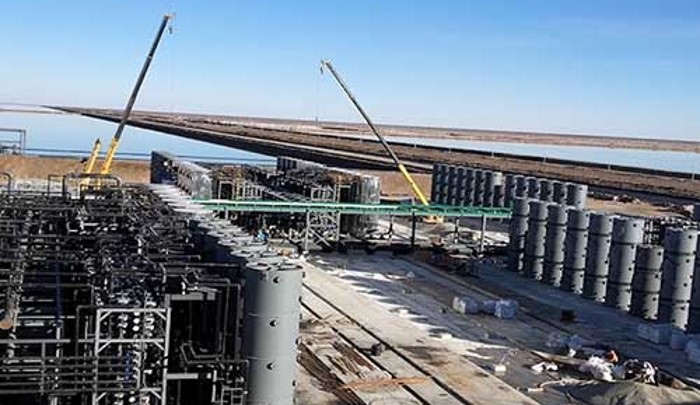
DLE from Brine |

Solar Evaporation Brine Extraction |
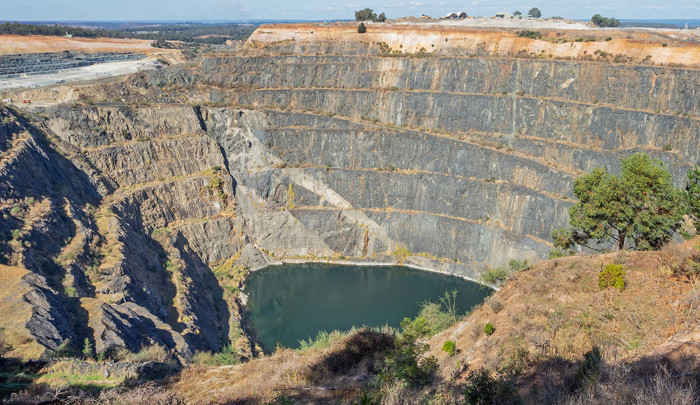
Hard Rock Mining |
|
|---|---|---|---|---|
| Feedstock | Produced water | Continental brine | Continental brine | Rock / spodumene |
| Project implementation time | 12-15 months | 5-7 years | 13-15 years | 8-10 years |
| Lithium carbonate production time | 2 hours | 2 hours | 2-3 years | 3-6 months |
| Lithium yield | >95% | 80-95% | 20-40% | 6-7% |
| Average footprint per 1,000 mt LCE | 1.4 acres | 1.4 acres | 65 acres | 115 acres |
| System design | Modular and mobile | Mobile / stationary | Stationary | Stationary |
| Environmental impact | Minimal | Minimal | Soil- and water contamination | Soil- and water contamination |
| Water consumption per 1,000 mt LCE | 20 million gallons | 80 million gallons | 550 million gallons | 250 million gallons |
| CO₂ footprint per 1,000 mt LCE | Neutral | 1.5 million kg | 5 million kg | 15 million kg |
| Average invested capital per 1,000 mt LCE | $18 million | $45 million | $50 million | $60 million |
| Average cost per metric ton | $4,550 | $5,700 | $5,800 | $6,900 |

Lithium Harvest Solution

DLE from Brine

Solar Evaporation Brine Extraction

Hard Rock Mining
Lithium Harvest’s Competitive Advantage
The race for lithium is heating up, and only the most efficient, sustainable solutions will win.
At Lithium Harvest, we’re not just keeping pace - we’re setting the benchmark. While traditional mining struggles with slow timelines and high environmental costs, our patented solution delivers lithium faster, cleaner, and more cost-effectively.
This is more than innovation - it’s a smarter path to meeting rising lithium demand and securing your place in the future energy economy.
-
Proven, Patented Technology
Backed by real-world performance, not just promises.
At Lithium Harvest, we combine Direct Lithium Extraction (DLE) with cutting-edge water treatment to deliver fast, efficient, and sustainable lithium recovery. Our technology has already been proven at scale by industry leaders, who produce over 70,000 tons of lithium annually.
The result? A commercially validated, low-risk solution ready for immediate deployment - built to meet soaring demand while slashing environmental impact.
-
Faster to Market
Why wait years when you can produce in months?
Traditional lithium mining is slow, expensive, and full of delays. Lithium Harvest’s modular system skips the long lead times and integrates directly with your existing oil and gas infrastructure. That means deployment in as little as 12-15 months, not 5 to 15 years.
Capitalize on soaring lithium demand while others are still stuck in permitting.
-
Scalable and Cost-Effective
Scale up without the cost drag.
Our modular system grows with your operations - whether you're managing one site or scaling across an entire basin. By tapping into the water you already generate, we cut CapEx and OpEx dramatically compared to traditional mining.
It's lithium production that fits your footprint - and your bottom line.
-
Environmental and Regulatory Benefits
Turn regulatory pressure into a business edge.
Our process flips the script on traditional mining - no habitat destruction, no water depletion, and no sky-high emissions. Instead, we turn your produced water into high-purity lithium while cutting carbon and using up to 96% less water than conventional methods.
It’s not just cleaner - it’s compliance-ready. With growing ESG demands and tighter regulations, our solution helps you meet environmental standards, strengthen stakeholder trust, and lead the energy transition, without adding complexity to your operations.
We believe that our patented technology is the fastest to market and lowest cost of any lithium mining technology in the market.
Strategic Fit and Market Opportunity for Oil & Midstream Companies
You already have the infrastructure, so unlock a whole new revenue stream.
As lithium demand skyrockets, oil and midstream companies are perfectly positioned to enter the critical minerals market. With produced water already flowing through your operations, you're sitting on an untapped resource that can fuel the energy transition.
By partnering with Lithium Harvest, you can diversify your business, drive profitability, and reduce reliance on volatile foreign supply chains. It's a strategic, low-risk entry into a booming market that aligns with national energy security goals and ESG expectations.
-
Using Existing Infrastructure
You already have the resource - now it’s time to unlock its value.
Produced water has long been treated as a costly byproduct, but it holds untapped potential. With Lithium Harvest’s patented extraction solution, your company can turn this underutilized stream into a revenue-generating asset.
By using your existing pipelines, treatment systems, and site infrastructure, you can enter the lithium market faster, with lower upfront costs and minimal operational disruption.
-
Diversification of Revenue Streams
Turn a cost center into a profit driver - without changing your core business.
Extracting lithium from produced water lets your company tap into a fast-growing global market using assets you already have. No major overhauls. No need to shift focus from your core operations.
What used to be a waste product can now fuel your bottom line and your ESG goals, making your business more profitable and future-ready.
-
Market Opportunity for the Oil and Gas Industry
Lithium demand is soaring, and the oil and gas industry is sitting on the solution.
As EV and battery manufacturers push for local, secure lithium sources, your infrastructure and operational know-how offer a direct path to meeting that demand. The opportunity? Turn produced water into a valuable resource - and a new revenue stream.
By partnering with Lithium Harvest, your company can unlock a sustainable, scalable solution that fits right into your existing operations. Together, we create powerful synergies that drive growth, strengthen domestic supply chains, and support the energy transition.
-
Energy Security
Tapping into lithium doesn’t just drive profits - it strengthens national security.
As countries race to secure critical minerals for the energy transition, your company can be part of the solution. By turning produced water into a domestic lithium source, you reduce reliance on foreign supply chains and reinforce energy independence.
This isn’t just an innovative business - it’s a strategic move that positions your company at the forefront of national resilience and the future of clean energy.
Partner with Lithium Harvest for Sustainable Lithium Extraction
Transform your operations. Tap into new revenue. Lead the energy transition.
At Lithium Harvest, we help oil and midstream companies turn produced water into high-purity lithium using proven, patented technology. With minimal disruption and no need for major infrastructure changes, you can unlock a scalable, low-risk path into the booming lithium market.
Let’s explore how our solution fits your operation and your strategy.
Contact us today to schedule a call and discover how Lithium Harvest can help you monetize waste, strengthen ESG performance, and stay ahead in energy evolution.

Capture growth in the booming lithium market
-
Tap into the booming lithium market: Capture growth opportunities in the rapidly expanding lithium sector, with demand projected to increase 3.5x by 2030 and 6.5x by 2034.
-
Strategic diversification: Expand revenue streams beyond traditional oil and gas by aligning with the green energy transition and high-growth markets.
-
Cost-efficient entry: Leverage your existing oilfield infrastructure and land resources for lithium extraction, supported by customized business scenarios for joint growth.
-
Easy, competitive, and fast: With our DBOO approach, we offer the fastest-to-market and most cost-effective lithium extraction technology available, providing a clear competitive edge.
Unlock the potential of sustainable lithium extraction today!
Download Brochure PDF, 788.73 KBNeed to Introduce Someone?
Want to help others understand the value of sustainable lithium extraction? Whether you're educating stakeholders, aligning your team, or exploring new business opportunities, our whitepapers are designed to make the case clear and compelling.
Give your team the insights they need to diversify operations, tap into new revenue, and lead the green energy transition - with Lithium Harvest by your side.
Contact Us
Our team of experts is ready to help you.


